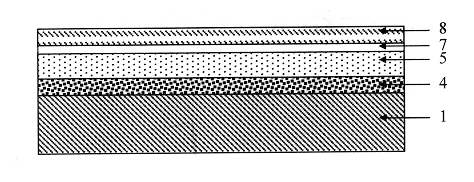Thin-film solar cells on the basis of IB-IIIA-VIA compound semiconductors and method for manufacturing same
a technology compound semiconductors, which is applied in the field of thin film solar cells on the basis of, can solve the problems of affecting the method in a detrimental way, affecting the development of flexible cis-solar cells so long, and peeling of the layers on glass substrates
- Summary
- Abstract
- Description
- Claims
- Application Information
AI Technical Summary
Benefits of technology
Problems solved by technology
Method used
Image
Examples
Embodiment Construction
A stainless steel film typically having a thickness of 10 .mu.m to 30 .mu.m normally serves as carrier film 1. The stainless steel film may further be covered by other metals or oxides. On the carrier film 1 there is located the back electrode 4 having a thickness of 1 .mu.m to 5 .mu.m. The back electrode 4 preferably consists of the intermetallic phase Cu.sub.7 In.sub.3. The polycrystalline absorber layer (PAS) 5 of the p-type conductivity--preferably consisting of the phase CuInS.sub.2 -- is arranged thereabove. The absorber layer typically has a thickness of 1 .mu.m to 3 .mu.m. The PAS 5 is closely intergrown with the back electrode 4 such that there will not occur any flaking. A thin buffer layer 7, preferably made of CdS, is arranged on the polycrystalline absorber layer 5. This buffer layer 7 has a thickness of 10 nm to 50 nm. A transparent bleeder electrode 8, preferably made of externally doped zinc oxide, is arranged on the buffer layer 7.
This solar cell has a thickness of ...
PUM
 Login to View More
Login to View More Abstract
Description
Claims
Application Information
 Login to View More
Login to View More - R&D
- Intellectual Property
- Life Sciences
- Materials
- Tech Scout
- Unparalleled Data Quality
- Higher Quality Content
- 60% Fewer Hallucinations
Browse by: Latest US Patents, China's latest patents, Technical Efficacy Thesaurus, Application Domain, Technology Topic, Popular Technical Reports.
© 2025 PatSnap. All rights reserved.Legal|Privacy policy|Modern Slavery Act Transparency Statement|Sitemap|About US| Contact US: help@patsnap.com

